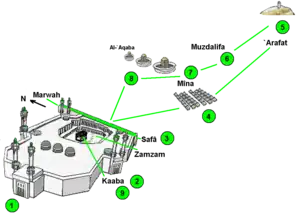| Part of a series on |
| Islamic jurisprudence (fiqh) |
|---|
| Islamic studies |
Ihram (Arabic: إِحْرَام, romanized: iḥrām, from the triconsonantal root Ḥ-R-M) is, in Islam, a sacred state which a Muslim must enter in order to perform the major pilgrimage (Ḥajj) or the minor pilgrimage (ʿUmrah). A pilgrim must enter into this state before crossing the pilgrimage boundary, known as Mīqāt, by performing the cleansing rituals and wearing the prescribed attire.
Restrictions
Wearing
A man in the state of ihram must not tie any knots or wear any stitched items. Sandals and flip flops must not be stitched either and should allow the ankle and back of foot to be exposed (some other schools of thought also agree that the front of the foot must be shown as well).
Men are also not allowed to cover the head or part of it by using a songkok, keffiyeh, turban, ihram cloth, etc. in the state of ihram.[1]
In the state of ihram, women and men are not allowed to wear gloves.[1]
Scents
Whilst in the state of ihram, a Muslim must not use any scents on the body or on the robes. If the robe has been fouled by najas (نَجَس, dirty) material or has been wiped, rubbed or touched by scented liquids (intentionally), then a new iḥrām clothing must be worn, or the Umrah or Hajj will be invalid.
Self-grooming
Aside from being as clean (purified) as they are for prayer, male Muslims are expected to cut their nails, and trim their hair and beards. They must also not wear any scent, including deodorant. They have to wear ihram clothing, which is a white, seamless garment. Many also shave their head as this is considered hygienic. Most will wait to shave their heads until after they have finished Umrah or Hajj, as this is a requirement to leave the state of ihram. Female Muslims are also expected to be clean. During the pilgrimage, sexual activity, smoking, and swearing are also forbidden.[2]
Environment

It is forbidden for every pilgrim of Hajj and Umrah when in his Ihram men and women to uproot, cut, break and grind the branches of trees and trees that are planted alive and growing in the Holy Land. This prohibition is also not allowed by any person present in the Holy Land (al-Haramain: Makkah, Madinah, Masyair Haram: Arafah, Muzdalifah and Mina, Jerusalem: Al-Aqsa Mosque). This is because, the trees that thrive in the Holy Land are the "Blessed Trees".
It is forbidden for every pilgrim of Hajj and Umrah while in his Ihram men and women to hunt, shoot, kill, sacrifice, capture, confine, destroy and abuse any land animal. This prohibition applies to every type of land animal, bird and insect other than marine animals.
If a person steps on or kills small animals/insects such as small black ants, grasshoppers, etc. by accident then he is not considered guilty but it is very necessary to pay the Dam according to the value of the insects killed.
A person is allowed to kill animals and insects that may cause him harm and endanger his sight and that of other pilgrims if he continues to leave it while in Ihram such as mosquitoes, snakes, scorpions and spiders without being subject to Dam, although it is preferable to only drive away the insect or animal first if possible.
When flying

When flying on pilgrimage, appropriate measures are usually taken to assure that the pilgrim will be in the state of ihram when flying above or alongside the stations of miqat.[3] For this reason some airports in Muslim areas have dedicated ihram rooms where pilgrims can change into the necessary clothing. If flying with an airline originating from a Muslim majority country, airline staff announce to be in the state of 'ihram' before entering in the boundaries of "Miqat".
See also
References
- 1 2 Ibadat haji umrah dan ziarah (in Malay). Lembaga Tabung Haji. 2002. ISBN 978-983-2819-06-6.
- ↑ "Ihram". hajjumrahplanner.com. 22 November 2016.
- ↑ al-Ghazali, Salih. "The point of Ihram for air travelers". The message of Islam. Archived from the original on 2016-08-11.
External links
- The Five Pillars of Islam, Hajj (Pilgrimage), The Fifth Pillar of Islam, Holy Sites/Mistakes of Pilgrims - An article on the many different beliefs surrounding the wearing of ihram by Sheikh Dr. Ghanim Saleh Al-Sadlan, professor of Higher Islamic Studies at the Imam Muhammad bin Saud Islamic University.
- Ihram Encyclopædia Britannica online
- ↑ "Knowledge Corner". Pilgrim Knowledge. Retrieved 2021-10-24.
